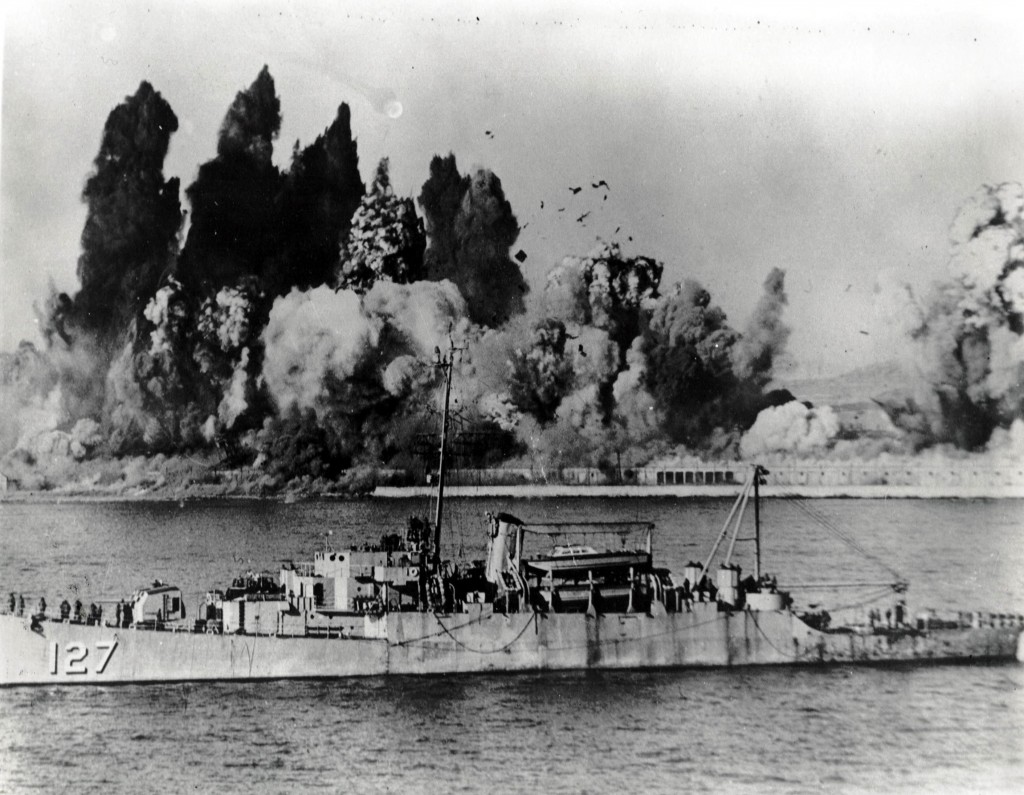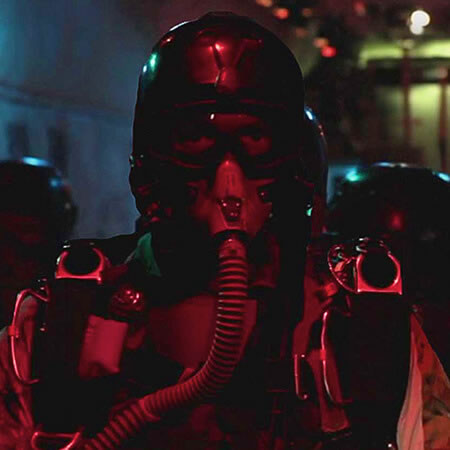SEAL History: Underwater Demolition Teams in the
Korean War
The Underwater Demolition Teams next saw action during the Korean War. Read how, from the start of the Korean War in 1950, to the Inchon Landings, to the armistice in July, 1953, Navy UDTs demonstrated remarkable versatility; laying the groundwork for expanded capabilities that would eventually evolve into the Navy SEALs.

UDT at Work at Inchon in Korea
Navy Frogmen Conduct First UDT Raid of Korean War
On the night of 5 August the detachment infiltrated from USS Diachenko (APD-123) with their inflatable boat to conduct a demolition raid against train tracks and a bridge-tunnel near Yosu. LTJG Atcheson and BM3 Warren “Fins” Foley, as the swimmer scouts, swam 200 yards ahead of the boat in swift current, exiting the water at a seawall just below their target. After patrolling up a 35-foot embankment and making a hasty reconnaissance, they signaled the remaining men to come ashore with the explosives. Suddenly 10 North Korean soldiers on a handcar came out of the tunnel and opened fire. Foley was hit and fell over the seawall. LTJG Atcheson threw several hand grenades that dispersed the enemy, and this allowed time for the UDT men to get clear and back to their boat for return to the Diachenko. Foley, who had a smashed kneecap and wounds in his hand and thigh, was the first U.S. Navy casualty of the Korean War.
New Kinds of Missions for Underwater Demolition Teams in Korea
During the month of August, additional UDT personnel began to arrive, and were committed to a continuation of this somewhat new mission–night coastal demolition raids against railroad tunnels and bridges. The UDT men were given the task because, in the words of UDT Lieutenant Ted Fielding, “We were ready to do what nobody else could do, and what nobody else wanted to do.” (Ted Fielding was awarded the Silver Star during Korea, and was later promoted to the rank of Captain). For the UDTs, the operational pace in the combat zone frequently found two of their platoons–approximately 30-men forward deployed to a particular Amphibious Personnel Destroyer (APD) for periods of six to eight weeks. Embarked UDT platoons usually ran between 10 and 20 demolition or beach reconnaissance missions while aboard the APDs; depending on weather and enemy activity. Moreover, individual UDT personnel were often away on temporary duty with other military or CIA units; usually for advisory and training duties. This included the forward-basing of small teams on islands close to the North Korean coastline, where they stood alert duty with UN Escape and Evasion organizations assisting in the recovery of downed airmen.
UDT Weapons and Demolitions
Individual weaponry taken by UDT men behind enemy lines was usually limited to the submachine guns, pistols, and knives found most useful for the close-quarters combat that characterized most raiding missions. Though presumably available, sound suppressors for the weapons are not known to have been used. The men used a variety of demolitions in their work, but the standardMark-135 Demolition Pack, which contained twenty pounds of C-3 plastic explosive was foremost.
Inchon Landings Navy UDT Support of Operation CHROMITE
On 15 September 1950 UDT men supported Operation Chromite, the amphibious landing at Inchon, which resulted in a decisive victory and strategic reversal in favor of United Nations allies. UDT-1 and UDT-3 personnel went in ahead of the landing craft, scouting mud flats, marking low points in the channel, clearing fouled propellers, and searching for mines.
UDT First Combat Dive Using Aqua Lung at Wonsan Harbor
In October 1950 the UDTs supported mine-clearing operations and acted as wave-guides for Marines at Wonsan Harbor. Also in October, two U.S. minesweepers, USS Pirate (AM-275) and USS Pledge (AM-277) hit mines and were sunk. UDT men rescued over 25 sailors. The next day, UDT operator William Giannotti conducted the first U.S. UDT combat-diver operation; using an “aqualung,” when he dove down to locate USS Pledge, and marked its location for later demolition by surface-supplied helmeted divers to destroy classified codes .
Navy Frogmen in North Korea Destroy Hungnam Harbor Facilities
On Christmas Eve 1950 an eight-man squad from UDT-3 destroyed the waterfront facilities at Hungnam, Korea by setting off over 20 tons of explosives after working for hours in severe cold, rain, and enemy sniper fire; as their support ship USS Begore (APD-127) beat off Chinese troops with its 5-inch guns. The demolition operation resulted in the largest single blast to be set off during the Korean War and the largest non-nuclear blast since WWII.
Operation FISHNET Last Major Operation Before Korean War Armistice
In September 1952, UDTs participated in Operation FISHNET (also known as SEANET), aimed to reduce North Korea’s food supplies by destroying fishing nets. Operations severely damaged the North Korean’s fishing capability, where the economy was based on fish as much as on rice. This was the last extensive UDT operation in the Korean War; an armistice ended fighting on 27 July 1953. For the remainder of the war, UDTs conducted beach and river reconnaissance, infiltrated guerrillas behind the lines from sea, and continued mine-location and clearance operations.
Changing Navy UDT Operational Doctrine
The Korean War substantially changed UDT operational doctrine; giving the men vastly expanded mission capabilities. In addition to their traditional roles of amphibious reconnaissance and mine and obstacle clearance, the UDTs saw the scope of their mission expanded to include stealthy infiltration from the sea to conduct raids and attack enemy shipping, port, and harbor facilities; clearance of ordnance from the high seas; intelligence gathering; and the covering of the withdrawal of friendly forces. In the early stages of the war fully half of the Navy’s entire UDT force had been committed to the conflict in less than six months. The Navy didn’t know what direction this new war might take or how long it might last, but it did know that any further requirements for UDT support in Korea would leave it with no option but to begin stripping the Atlantic Fleet UDTs of their personnel. UDT-1 and UDT-3 supported the early stages of the Korean War, but in September 1951 UDT-5 was established to provide some relief in combat rotations; hence, the Atlantic Fleet UDTs were never committed to battle. UDT-2 and UDT-4 based in Little Creek, Virginia were involved in experimental programs involving the Aqua Lung development, lock-out and lock-in diving operations from submerged submarines, cold-weather diving operations, parachute training, and development and testing of miniature submarines and combatant submersibles.
Business as Usual
Regardless their success in Korea, it would be quickly realized that the post-war Navy was not willing to change the status of the UDTs in response to Cold War realities. As far as the Amphibious Force was concerned, improved training within a WWII mission profile context was sufficient. This would not change until establishment of SEAL Team ONE and SEAL Team TWO in January 1962.

SITREP Sign-up
Be among the first to know the latest news and intel out of the Navy SEAL Museum San Diego.
